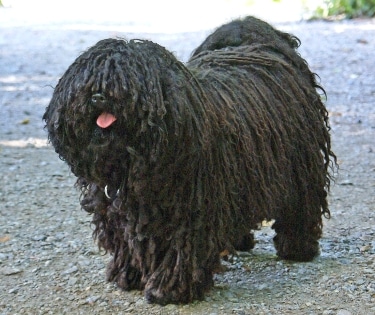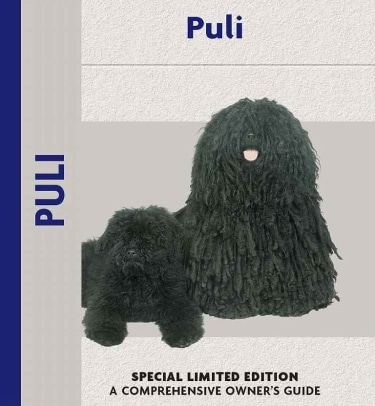
The Puli’s coat is his most striking and unique feature. Loaded with cords or tassels and reaching the ground, this characteristic coat certainly makes quite an appearance. The Puli is an affectionate, intelligent, obedient and cheerful breed. He has an ancient lineage dating back more than a 1000 years ago. It is believed when the Magyars migrated from Central Asia to Hungary, the sheepdogs they brought with them were likely ancestors of the Puli.
Another similar breed to the Puli and also connected with the ancient Magyars is the Komondor. Both breeds worked together guarding livestock and property. While the Puli was guarding and herding livestock during the day, the Komondor guarded at night. Also, if a large animal threatened the livestock, the Puli would bark to alert the very large and fearless Komondor that would then fend off the intruder.
During the sixteenth century and unrest in Hungary, the Puli breed was mixed with other sheepdogs from Germany and France resulting in dogs referred to as Pumi. Ultimately, this severely threatened the survival of the true Puli breed. In the early 1900s, Emil Raitsits succeeded in reviving the Puli and the first breed standard was written in 1915. The Puli was then officially recognized by the American Kennel Club in the Herding Group in 1936.
Height: The AKC Standard for the ideal height of a Puli is between 16 and 17 inches (41 – 43 cm) when measured at the shoulder. Dogs are taller than bitches.
Weight: The weight of a Puli can range from 20 – 35 pounds (9 – 16 kg). Dogs weight more than bitches.
Coat Type: The Puli’s coat is profuse and dense with naturally formed cords or tassels – the most unique feature of this breed. The Puli has a double coat – the outer coat is coarse and can be wavy or curly and the undercoat is thick, soft and woolly. The cords on the Puli do not fully form until the Puli is about 9 months old and the length will not reach the ground for 4 – 5 years. A Puli may need your assistance helping to separate the cords into the right measurements so that it’s open to the skin. Pulis hardly shed at all. They should be bathed only when necessary (their coat is odorless) and it can take up several hours for it to dry or up to a couple of days if a dryer is not used.
Color: The color of the Puli’s coat can be solid black or white. It can also be a mixture of black with white hairs, in which the Puli’s coat will then appear solid gray, charcoal, or silver.
Temperament: The Puli has a lively temperament and is affectionate and very devoted to his master. He is great with children, playful throughout his life, and he thrives on attention and human interaction. The Puli is intelligent and does very well with training, although at times he can be stubborn (his master needs to be a strong leader). The Puli is very protective of his family and is suspicious of strangers making him great watch dog. He is active and should be exercised daily – either long walks, a jog and free play, especially if his owner or family is involved in the fun.
Health Concerns: The Puli is a healthy breed, although your breeder should check for these common problems which can affect any dog: hip dysplasia, hearing and eye problems. The average life expectancy for a Puli is between 10 – 15 years.
Special Interest:
• The Puli has a distinctive coat like no other breed.
• The Puli is an ancient breed and is related to the Hungarian sheepdog.
• The Puli’s coat is most commonly black.
Classifications:
AKC: Herding Group
ANKC: Working – Group 5
CKC: Herding – Group 7
FCI: Group 1 Section 1 Sheepdogs
KC: Pastoral
NZKC: Working
UKC: Working Dog
 Kennel.com – Complete Guide to Dogs The Dog Lovers Guide
Kennel.com – Complete Guide to Dogs The Dog Lovers Guide
 PULI
PULI